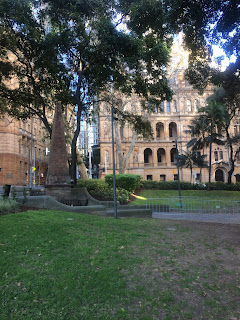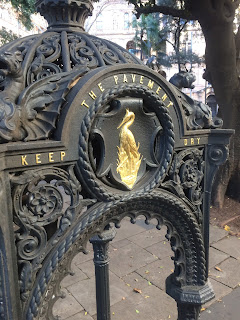Governor Phillip's Garden
Macquarie Place, Near South Western Corner
David Collins Remarked "Some Ground Having Been Prepared Near His Excellency's House On The Eat Side, The Plants From Rio De Janeiro And The Cape Of Good Hope Were safely Brought To Shore In A Few Days; And We Soon Had The Satisfaction Of Seeing The Grape, The Fig, The Orange, The Pear And The Apple, taking Root And Establishing Themselves In Our New World"
Surgeon General John White in His Journal Of A Voyage To New South Wales Wrote About The Sick Suffering From Dysentry And Scurvy.
"His Excellency, Seeing The State These Poor Objects Were In, ordered A Piece Of Ground To Be Inclosed, For The Purpose Of Raising Vegetables For Them. The Seeds That Were Sown Upon This Occassion, on first Appearing Above The Ground, Looked Promising And Well, Which Was Not Indeed Wxtraordinary, As They Were Not Sown At A Proper Season Of The Year."
In May 1788 Governor Phillip Gloomily
Commented "From The Great Labour Which Attended The Clearing Of The Ground, It Proved Impracticable To Sow More Than Eight To Ten Acres With Wheat And Barley; And It Was Feared That Even This Crop Would Suffer From The Depredations Of Ants And Field
nice.
Two Bunches Of Grapes Were Plucked On The 24th January 1791, Three years Later. And
"It Was Predicted In The Vehemence Of Expectation That Their Juice Will Hereafter Furnish An Indisputable Article Of Luxury At European Tables."
Lieutenant P.G. King on 29th January Noted In Their Journal: - "Some Convicts Digging Up The Ground for A Garden."
Surgeon General John White Travelled On The Transport Charlotte to Botany Bay With The First Fleet, And Remained In New South Wales Until December 1794, After Which He Returned To England. While In England's Newest Colony, The Peppery Doctor, Besides Collecting Material On The Fauna And Flora Of The Colony, Fought A Duel With His Assistant, Dr William Balmain. White's Book - Journal Of A Voyage To New South Wales, Published In 1790 Carried - Sixty Five Illustrations Of Non Descript Animals, Birds, Lizards, Serpents, Curious Cones Of Trees And Other Natural Productions."
John White Died In Sussex, England in 1832.





































































































